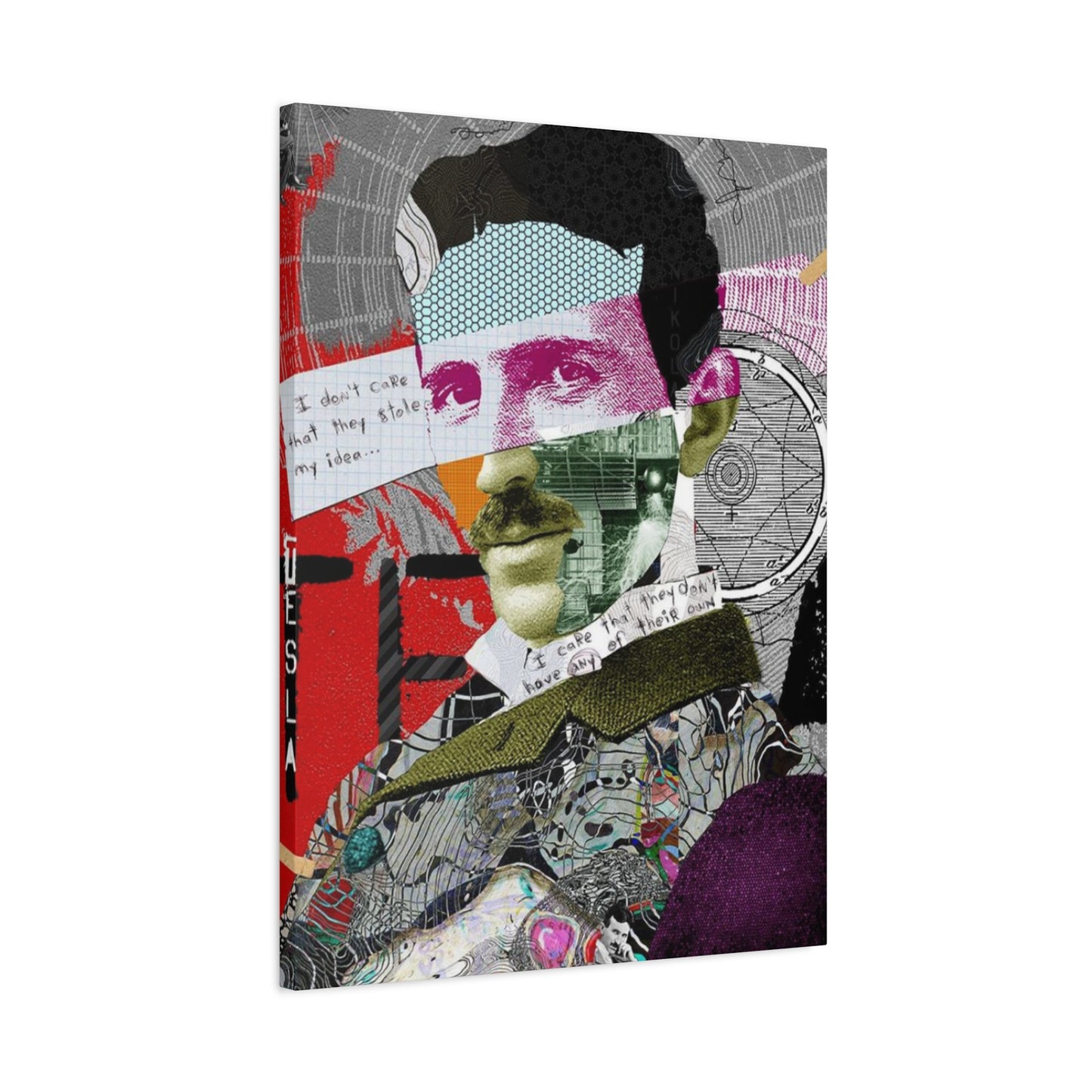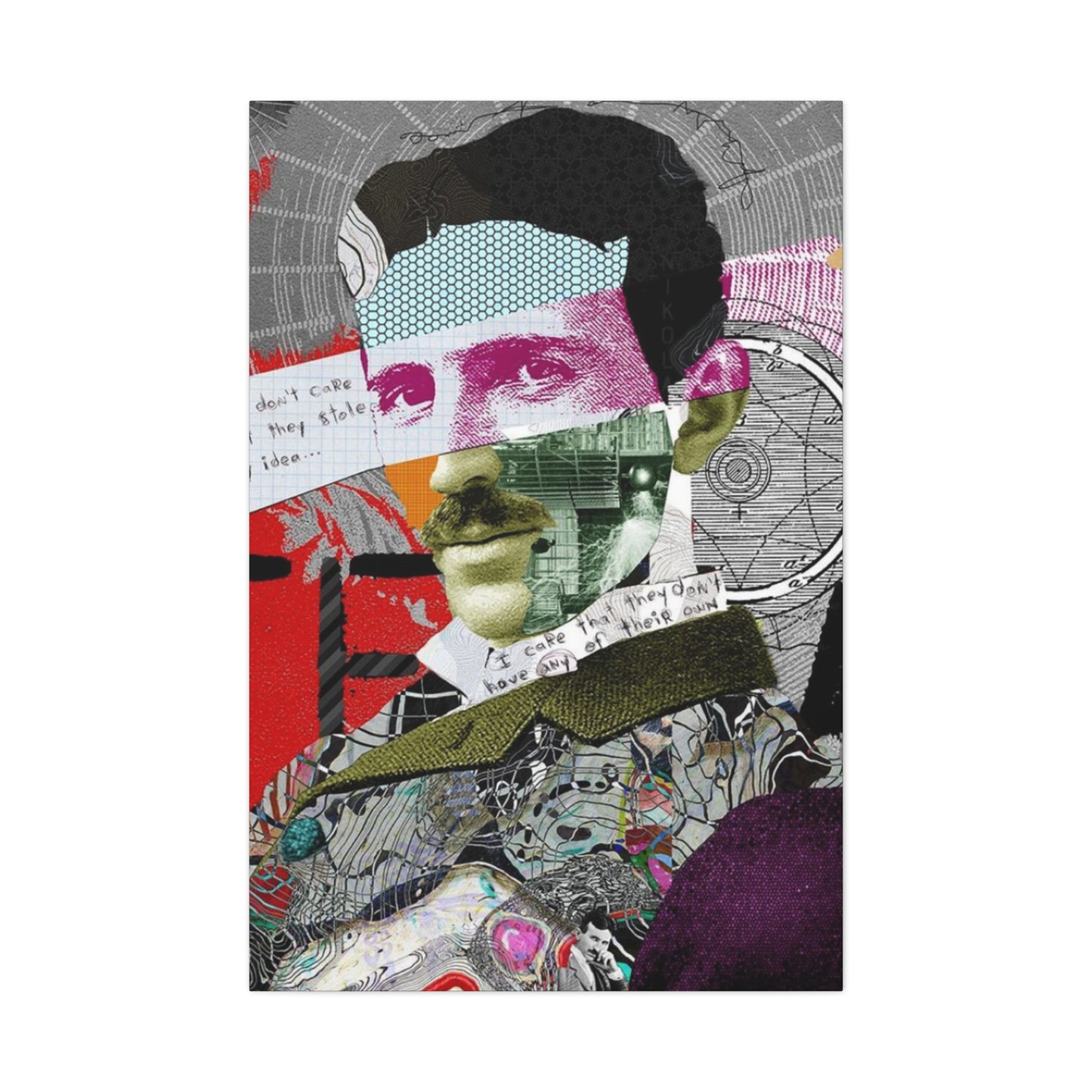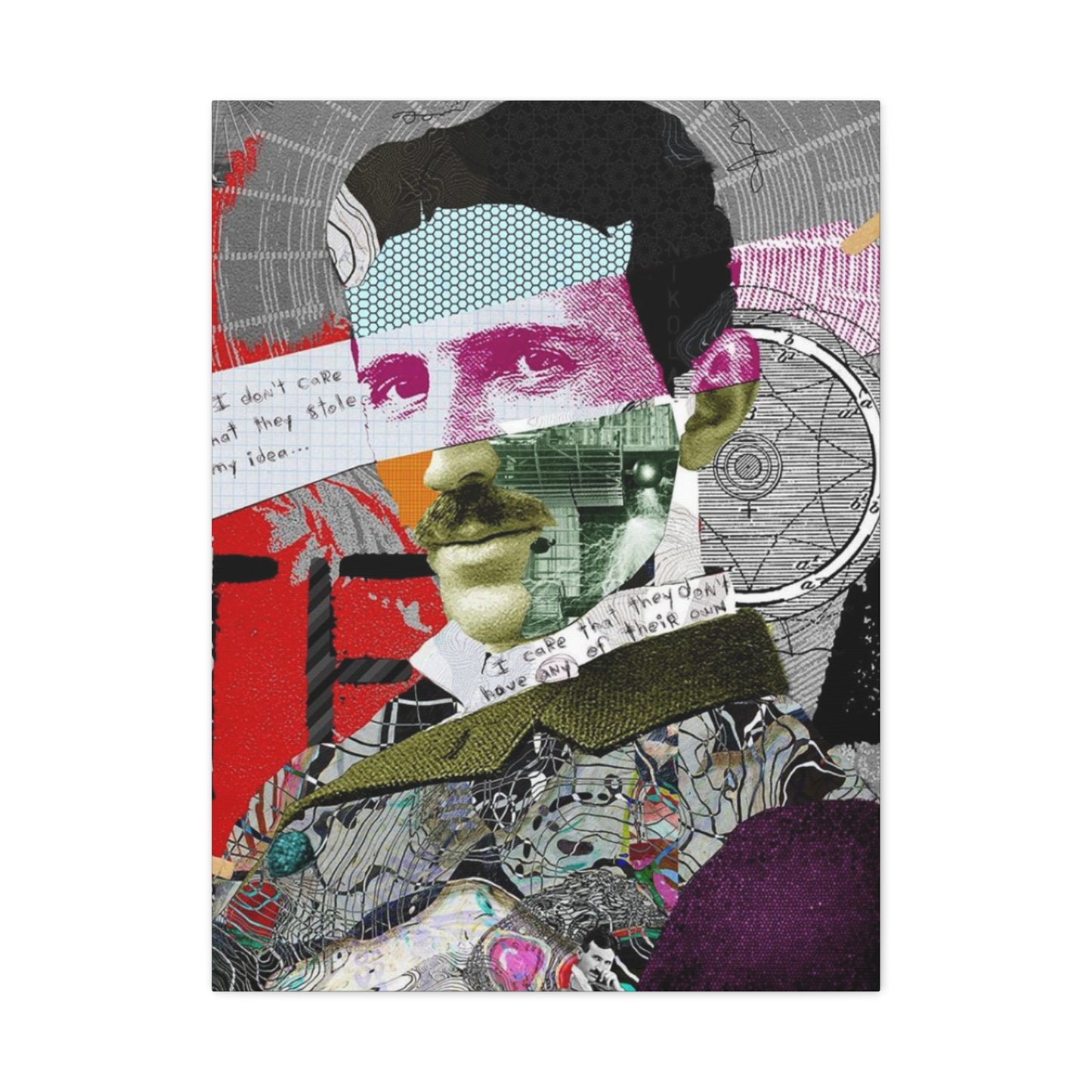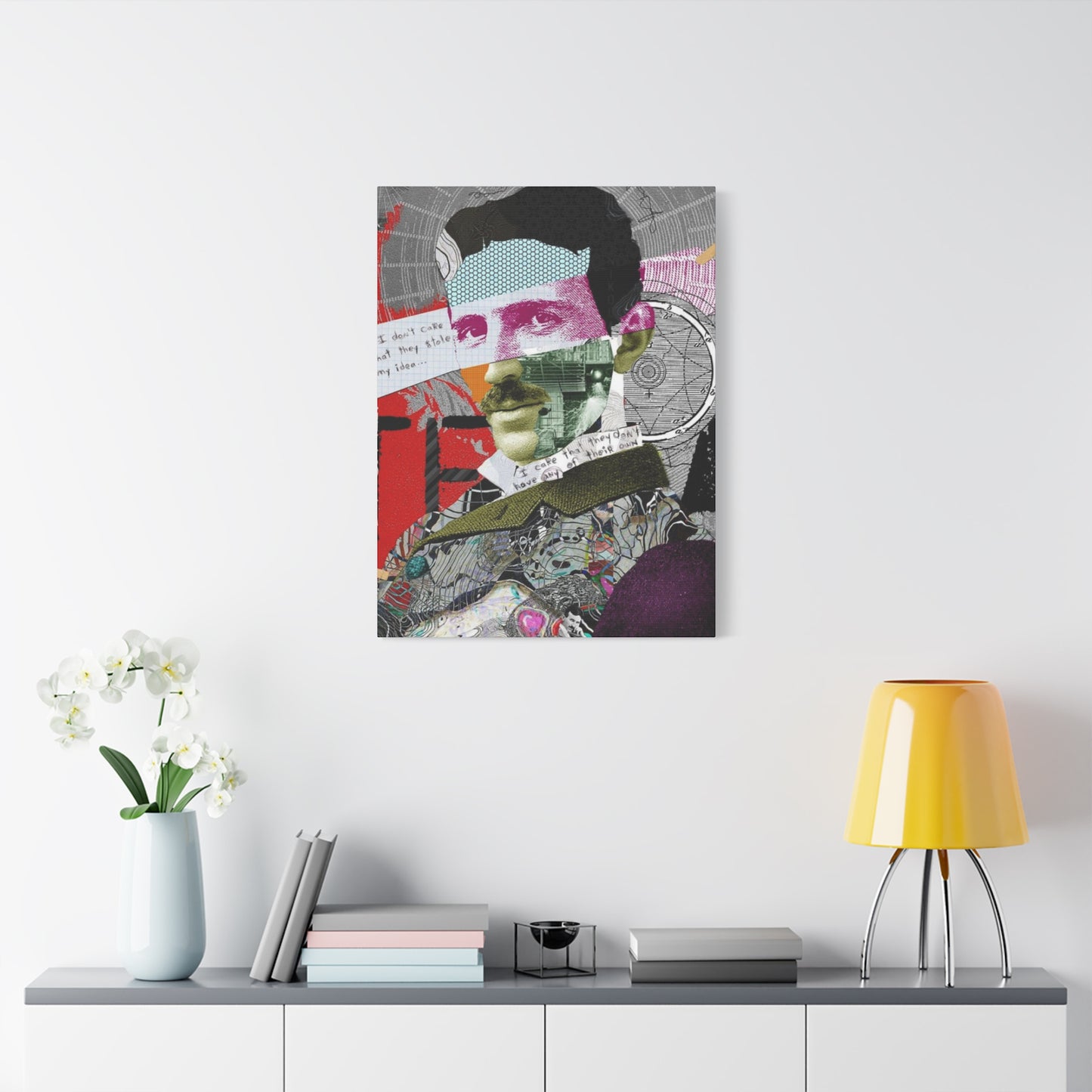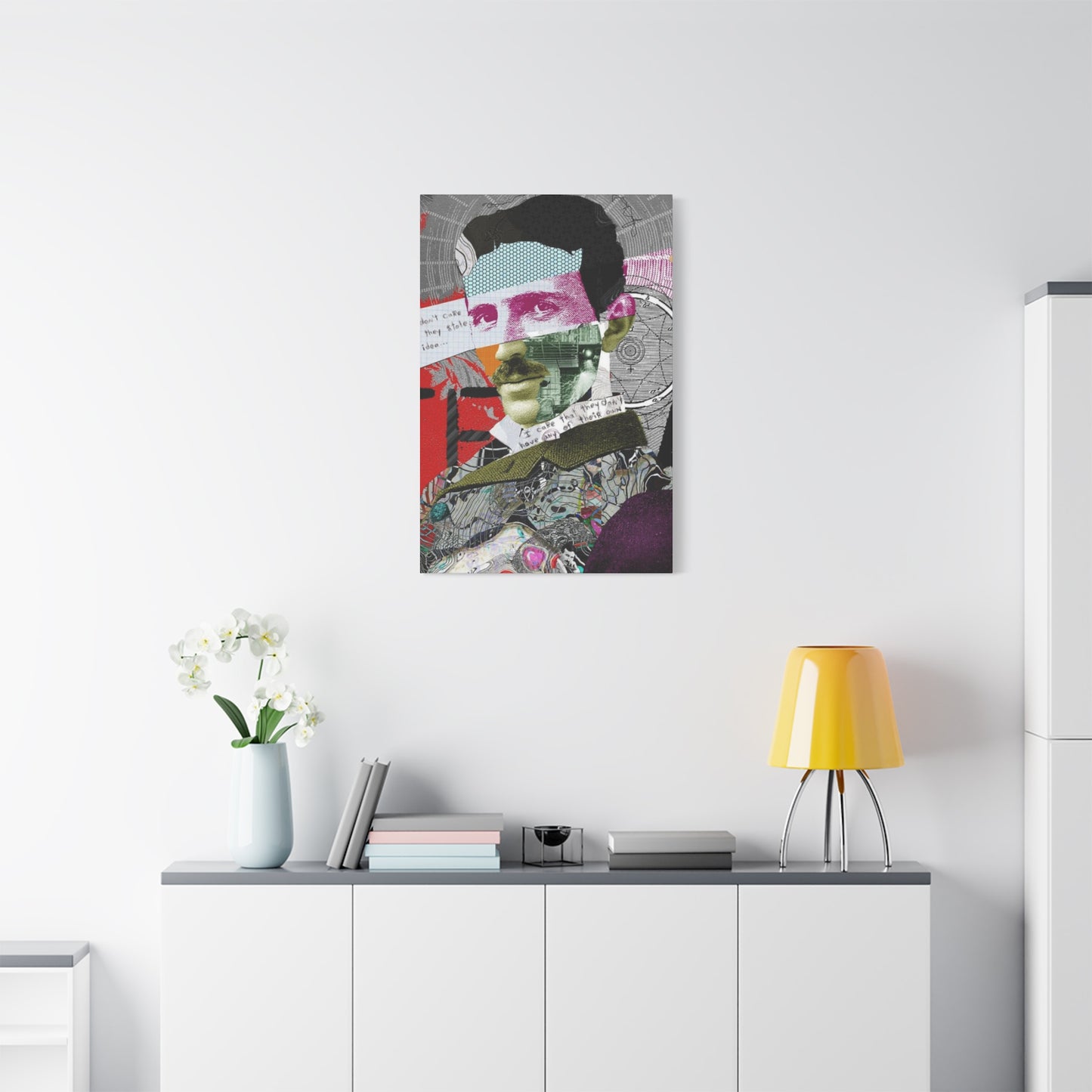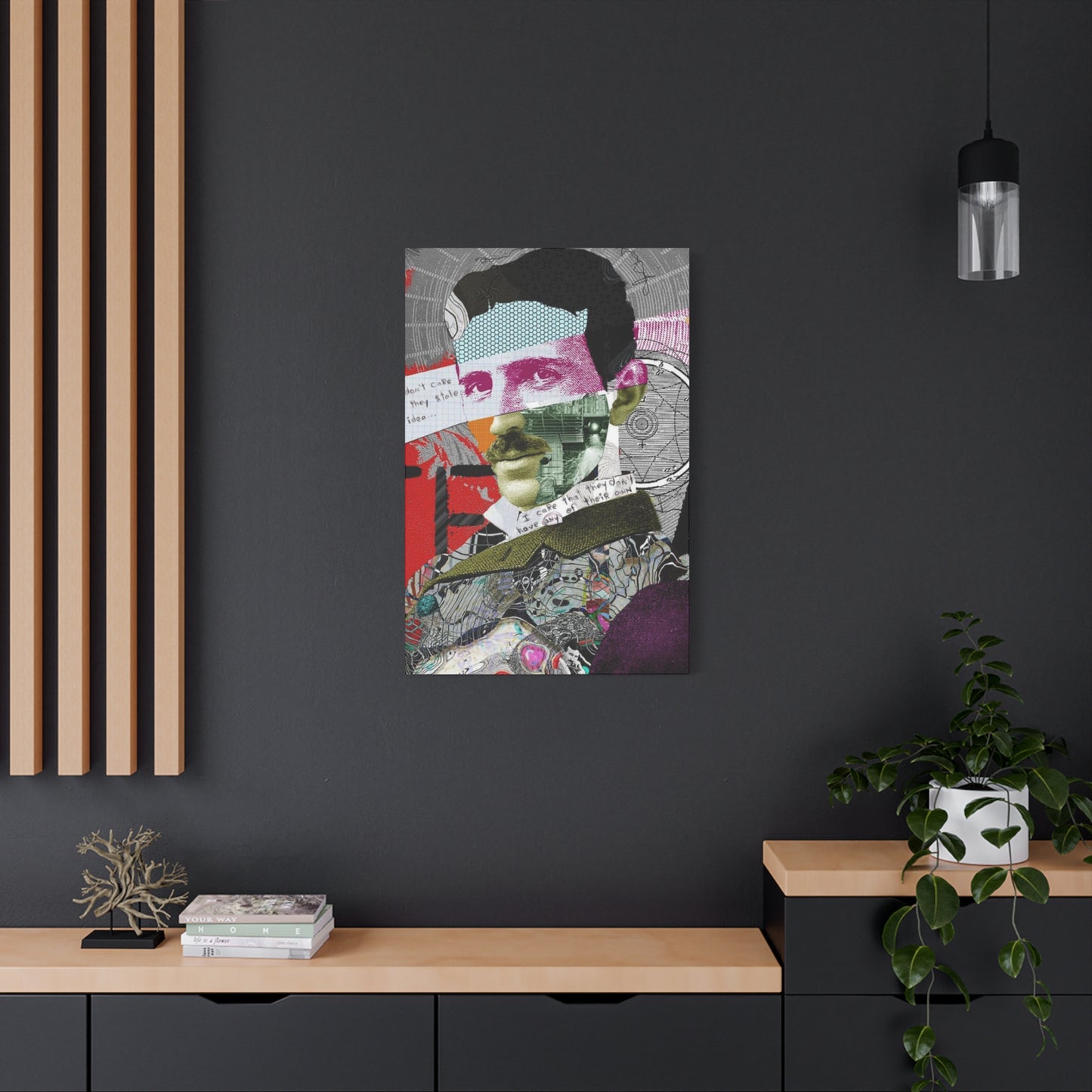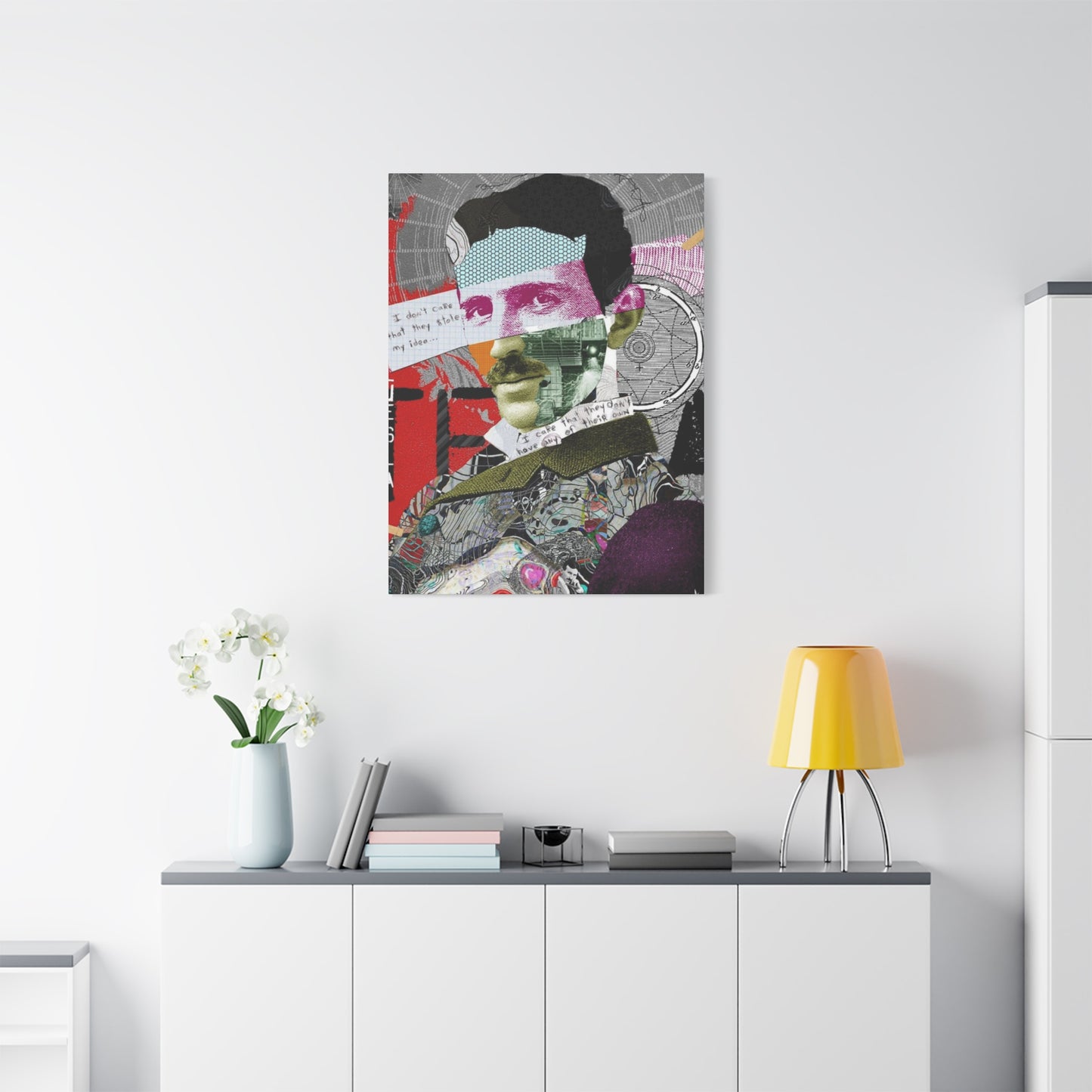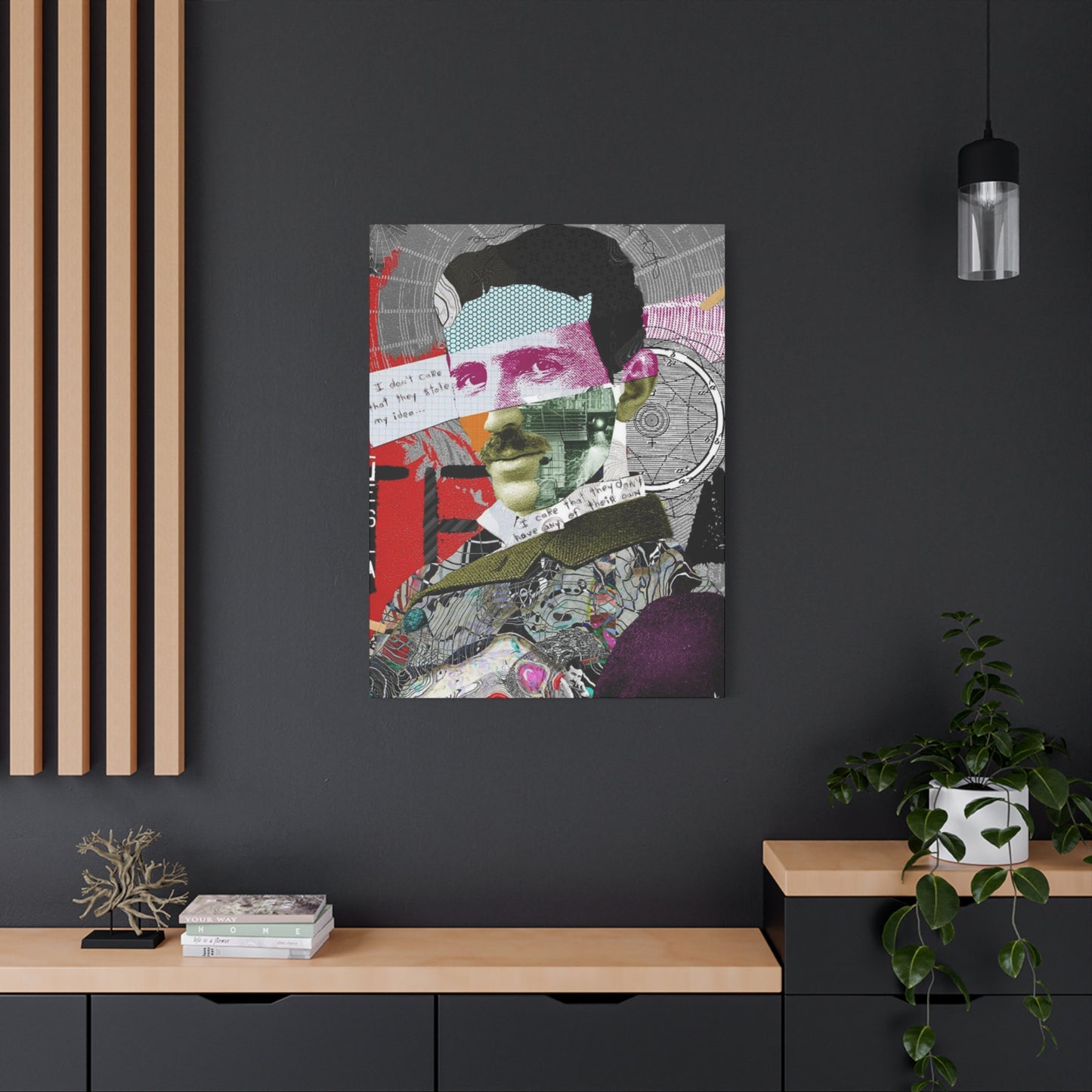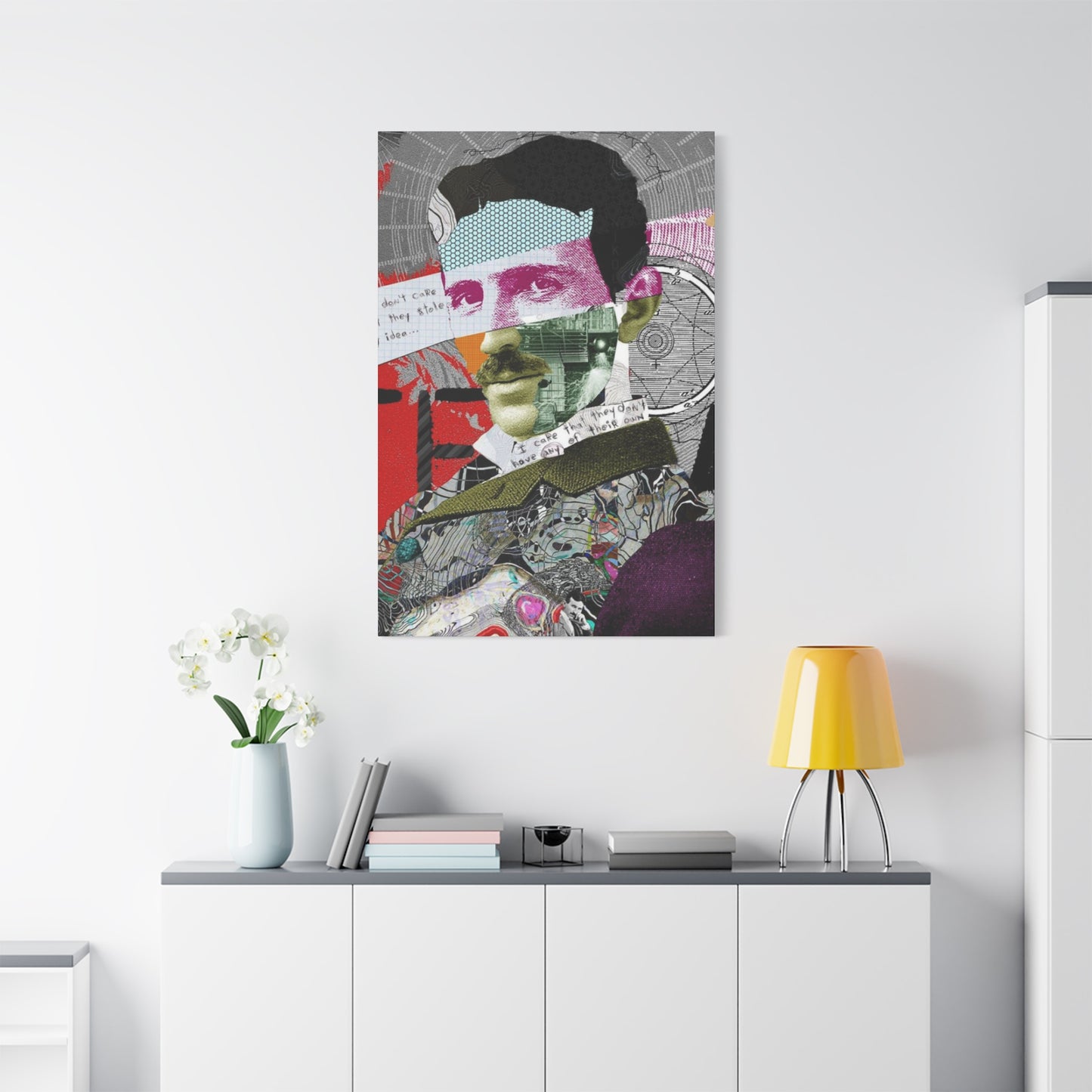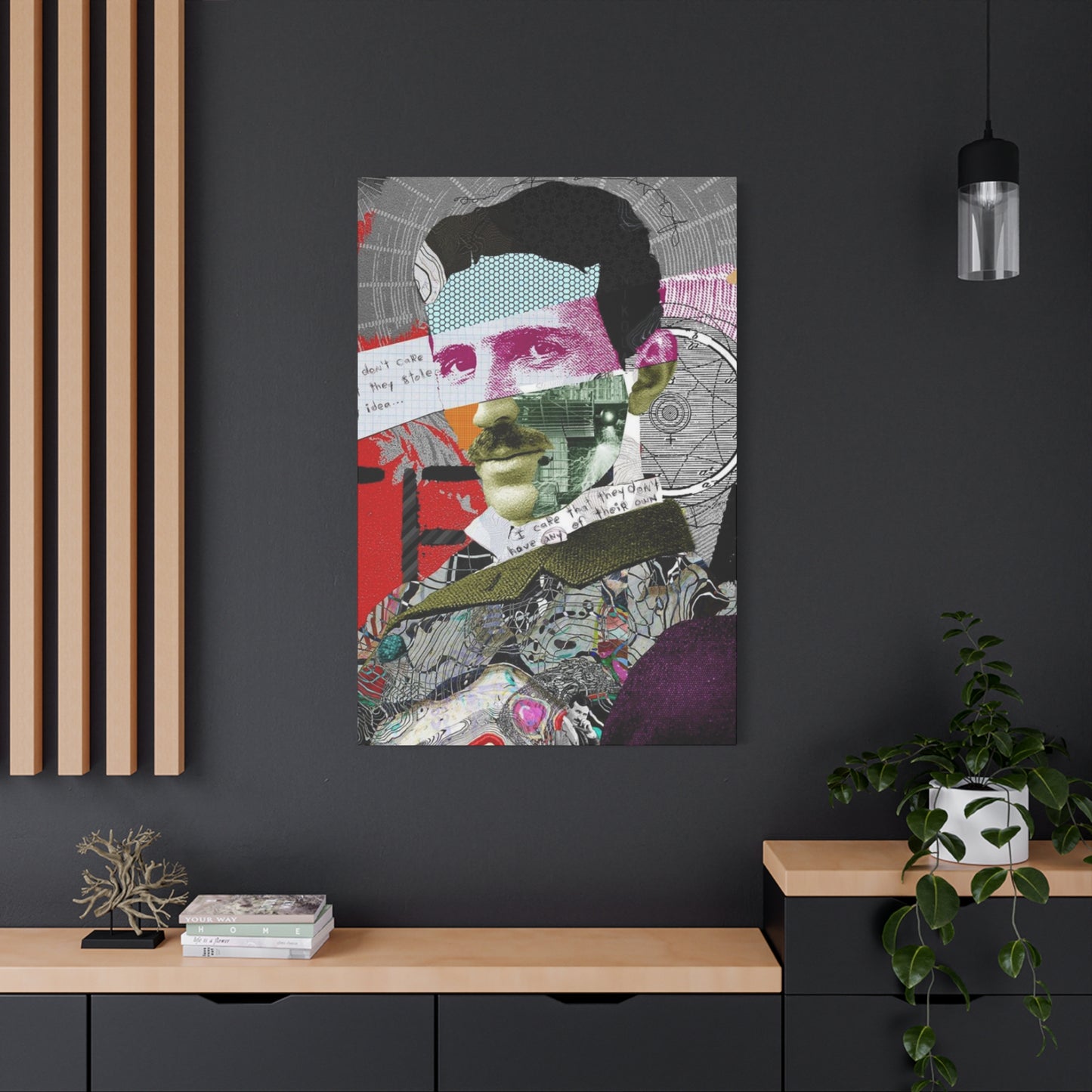Exploring the Human Condition: Contemporary Man Abstract Painting mixed media Wall Art
Man abstract painting represents a powerful intersection of human form and non-representational artistic expression. This genre focuses on deconstructing the male figure through various abstract techniques, creating pieces that challenge traditional portraiture while maintaining an emotional connection to the human experience. Artists working in this style often blur the boundaries between recognizable human features and pure abstraction, allowing viewers to interpret the masculine form through their own perspectives and emotional responses.
The evolution of man abstract painting has been influenced by numerous art movements throughout history, from Cubism's fragmented perspectives to Abstract Expressionism's emotional intensity. Contemporary artists continue to push these boundaries, incorporating mixed media techniques that add depth and texture to their canvas prints. The male figure becomes a starting point for exploration rather than the final destination, with artists using color, form, and composition to evoke feelings about masculinity, identity, and the human condition.
When examining man abstract painting, viewers encounter layers of meaning that extend beyond the visible surface. The abstraction of the male form allows for conversations about vulnerability, strength, isolation, and connection. These artworks often feature bold brushstrokes, unexpected color combinations, and fragmented compositions that reflect the complexity of modern masculine identity. Canvas prints of these original works bring this sophisticated artistic dialogue into homes and offices, making contemporary art accessible to a broader audience.
The Rising Popularity of Mixed Media Wall Art
Mixed media wall art has experienced tremendous growth in popularity over recent decades, becoming a dominant force in contemporary interior design and artistic expression. This approach combines various materials and techniques within a single artwork, creating rich visual experiences that cannot be achieved through traditional single-medium methods. Artists incorporate everything from acrylic paints and oils to found objects, fabric, paper, metal, and digital elements, resulting in pieces with remarkable depth and tactile appeal.
The appeal of mixed media wall art lies in its ability to engage viewers on multiple sensory levels. Unlike flat, single-medium paintings, mixed media pieces invite closer inspection, revealing new details and textures with each viewing. This complexity makes them ideal for spaces where people spend significant time, as the artwork continues to offer fresh discoveries and maintain visual interest over years of display. The dimensional quality of mixed media also plays exceptionally well with contemporary lighting, casting subtle shadows and highlights that change throughout the day.
Collectors and interior designers increasingly favor mixed media wall art for its versatility and contemporary aesthetic. These pieces bridge the gap between traditional painting and sculptural relief, offering a modern alternative to conventional framed prints. The incorporation of diverse materials allows artists to express concepts that might be difficult to convey through paint alone, adding conceptual depth to visual appeal. When featuring man abstract painting within mixed media contexts, artists can incorporate materials that reference masculinity, industry, or personal history, enriching the narrative potential of their work.
Canvas Prints as an Accessible Art Form
Canvas prints have revolutionized art accessibility, making high-quality reproductions of original artworks available to audiences worldwide. This printing method transfers digital images onto canvas material using specialized printers and archival-quality inks, creating results that closely mimic the appearance of original paintings. The canvas texture adds authenticity and visual interest that paper prints cannot match, while the stretched gallery-wrap presentation eliminates the need for framing, reducing both cost and installation complexity.
The technology behind modern canvas prints has advanced significantly, allowing for exceptional color accuracy and detail reproduction. Museum-quality giclée printing processes use pigment-based inks that resist fading for decades when properly displayed, ensuring that canvas prints maintain their visual impact over time. This longevity makes them legitimate alternatives to original artworks for many collectors, particularly when acquiring pieces by established artists whose originals command prices beyond typical budgets. Man abstract painting particularly benefits from canvas printing, as the texture of the material complements the layered, dimensional quality of the original works.
Beyond affordability, canvas prints offer practical advantages that appeal to contemporary consumers. They are lighter and more durable than framed glass-covered prints, making them easier to hang and less prone to damage during installation or relocation. The frameless presentation creates a modern, gallery-quality appearance that suits contemporary interior design preferences. Additionally, canvas prints can be produced in custom sizes, allowing buyers to select proportions that perfectly fit their spaces. This flexibility has made canvas prints the preferred choice for residential and commercial installations seeking sophisticated artistic impact without the investment required for original artworks.
Material Choices in Contemporary Mixed Media
The materials artists select for mixed media wall art fundamentally shape both the appearance and conceptual content of their works. Traditional fine art materials like oil paint, acrylic, and watercolor form foundations that artists augment with unconventional additions. In man abstract painting, artists might incorporate industrial materials like metal fragments, wire, or concrete to reference masculine associations with construction and manufacturing. Organic materials such as wood, paper, or fabric can soften compositions, introducing contrasts between hard and soft, manufactured and natural. These material choices become part of the artwork's meaning, with each substance carrying cultural associations that inform interpretation.
Adhesives and binding agents represent crucial but often overlooked materials in mixed media practice. Artists use various glues, gels, and mediums to attach elements to canvas surfaces and seal layers, ensuring structural integrity while sometimes contributing visual effects. Matte mediums preserve color fidelity, while gloss mediums enhance vibrancy and create reflective surfaces. Some artists incorporate resin coatings, adding glass-like finishes that unify disparate materials and protect surfaces. When these original mixed media works are reproduced as canvas prints, the photographic process must capture how different materials interact with light, preserving the visual complexity that makes mixed media compelling.
Archival considerations influence material selection for serious artists creating mixed media wall art intended for longevity. Acid-free papers, lightfast pigments, and stable adhesives prevent degradation, yellowing, and deterioration over time. While experimental artists might deliberately use ephemeral materials as conceptual statements about impermanence, most creators of man abstract painting for canvas print reproduction use archival materials to ensure works remain vibrant and intact. Collectors should inquire about materials used in original works and reproduction processes, as archival quality directly affects investment value and long-term satisfaction with purchased canvas prints.
The Role of Negative Space in Abstract Composition
Negative space, the unmarked or less active areas within compositions, plays as important a role as positive elements in successful abstract artwork. Skilled artists understand that what they leave out matters as much as what they include, using empty or quiet areas to provide visual rest and emphasize active zones. In man abstract painting, negative space might represent psychological void, isolation, or simply create breathing room that prevents compositional claustrophobia. The interaction between figure and ground becomes a dynamic conversation, with neither dominating entirely but each contributing to overall compositional balance.
Strategic use of negative space creates rhythm and movement within mixed media wall art. By varying the amount and placement of empty areas, artists control pacing, determining how quickly or slowly viewers' eyes travel across the canvas surface. Concentrated bursts of activity surrounded by calm areas create focal emphasis, while more evenly distributed elements generate all-over compositions without clear hierarchy. Man abstract painting often employs negative space to suggest the fragmentary nature of identity and perception, with figural elements emerging from or dissolving into undefined backgrounds. This approach reflects contemporary understanding of selfhood as fluid and contextual rather than fixed and absolute.
In canvas prints, negative space serves practical functions beyond aesthetic considerations. Substantial unmarked areas can visually recede, making walls behind artworks feel less confined and spaces appear larger. This quality makes mixed media wall art with significant negative space particularly suitable for smaller rooms or dense interiors where additional visual complexity would create overwhelm. The simplicity of well-designed negative space also photographs and reproduces reliably, ensuring canvas prints maintain compositional integrity. Collectors selecting man abstract painting should consider their spaces and personal preferences regarding visual density, choosing works whose balance of positive and negative space aligns with their environmental needs and aesthetic sensibilities.
Stylistic Variations Within Abstract Male Portraiture
Man abstract painting encompasses diverse stylistic approaches, each offering distinct visual experiences and conceptual frameworks. Geometric abstraction reduces the figure to essential shapes, using circles, rectangles, triangles, and other defined forms to construct simplified representations. This approach emphasizes structure and order, often creating compositions with architectural qualities. Artists working geometrically might fragment the male figure into overlapping planes reminiscent of Cubism, or reduce forms to pure shapes that suggest rather than describe human presence. The clean edges and clear forms of geometric abstraction translate particularly well to canvas prints, maintaining crispness across reproduction processes.
Gestural or expressive abstraction prioritizes emotional immediacy and visible evidence of the artist's physical engagement with materials. Loose, energetic brushwork characterizes this approach, with drips, splatters, and sweeping marks creating dynamic surfaces. Man abstract painting in gestural styles often conveys raw masculinity through aggressive mark-making, though artists also subvert expectations by employing delicate gestures to explore nuanced emotional territories. The spontaneous quality of gestural work creates visual excitement, with each brushstroke contributing to overall compositional energy. Mixed media wall art in this style benefits from high-resolution reproduction that captures subtle variations in mark quality and paint application.
Lyrical or color-field approaches to abstract figure work emphasize atmospheric effects and subtle color transitions over defined forms or dramatic gestures. These pieces often feature soft edges, blended hues, and contemplative moods. Man abstract painting in lyrical modes might dissolve the figure into veils of color, suggesting presence through tonal variation rather than clear delineation. This approach creates meditative viewing experiences, with colors and values shifting subtly across canvas surfaces. Canvas prints of lyrical abstractions require exceptional color management and tonal range reproduction to preserve the delicate relationships that define these works. Each stylistic variation offers different strengths, allowing collectors to select man abstract painting that aligns with their personal aesthetic preferences and intended display contexts.
Cultural Influences on Contemporary Abstract Art
Contemporary man abstract painting draws from global artistic traditions, reflecting our interconnected cultural moment. African mask traditions influence many abstract approaches to the human face, with their emphasis on essential features and symbolic rather than literal representation. Asian calligraphy and ink painting contribute gestural techniques and philosophical approaches that value spontaneity and spiritual connection between artist and material. Indigenous art traditions from various continents inform approaches to pattern, symbol, and the relationship between figure and environment. This cross-cultural pollination enriches abstract art, creating hybrid forms that transcend any single tradition.
Street art and graffiti culture have significantly impacted contemporary mixed media wall art, introducing techniques like spray painting, stenciling, and layered text elements into fine art contexts. Urban aesthetics inform color choices, compositional strategies, and attitudes toward the picture plane as public space for communication. Man abstract painting influenced by street art often incorporates bold graphics, fragmented text, and references to popular culture, creating works that speak to contemporary experience in accessible visual languages. Canvas prints of these urban-influenced pieces bring gallery-quality sophistication to street art aesthetics, making them suitable for residential and corporate interiors.
Digital culture increasingly shapes abstract artistic practice, with artists using computer software for planning, incorporating digital imagery, or responding to the aesthetic of screens and pixels. Some creators of man abstract painting deliberately contrast digital smoothness with analog materiality, using traditional media to assert human presence against technological dominance. Others embrace digital tools, creating works that blur boundaries between painting and digital art. Canvas prints serve as ideal media for presenting digitally-influenced work, as the printing process seamlessly handles both photographed paintings and digitally created images. This cultural moment of technological transformation provides rich conceptual territory for abstract artists exploring what it means to be human, and specifically male, in increasingly digital environments.
Psychological Impact of Abstract Visual Experiences
Abstract art affects viewers psychologically in ways distinct from representational imagery. Without clear narrative content or recognizable subjects to decode, viewers engage more directly with formal elements like color, composition, and texture. This direct sensory engagement can bypass intellectual analysis, creating emotional responses rooted in perception rather than interpretation. Man abstract painting leverages this immediacy, using visual elements to evoke feelings about masculinity, identity, and human experience without prescribing specific meanings. The ambiguity of abstraction allows personal projection, with each viewer bringing individual experiences and associations to their encounter with the artwork.
Research in environmental psychology demonstrates that visual environments significantly influence mood, stress levels, and cognitive performance. Mixed media wall art contributes to these environmental effects, with color choices particularly impactful. Cool-toned abstract works can create calming environments suitable for relaxation or focused work, while warm, vibrant pieces energize spaces and stimulate conversation. The complexity of well-executed man abstract painting provides visual interest that maintains engagement without causing overstimulation, supporting mental well-being through aesthetic enrichment. Canvas prints make these psychological benefits accessible, allowing people to curate their environments with art that supports their emotional and cognitive needs.
The interpretive openness of abstract art also offers psychological benefits, encouraging creative thinking and tolerance for ambiguity. Engaging with man abstract painting requires viewers to make sense of visual information without clear answers, exercising mental flexibility and comfort with uncertainty. These cognitive skills transfer to other life domains, supporting adaptability and creative problem-solving. For individuals or organizations seeking to foster innovative thinking, surrounding themselves with abstract mixed media wall art creates environmental reinforcement for these valuable mental habits. Canvas prints of quality abstract works thus serve functions beyond decoration, contributing to spaces that support psychological health and cognitive development.
Technical Aspects of Canvas Print Production
Professional canvas print production involves sophisticated technical processes ensuring faithful reproduction of original artworks. The workflow begins with high-resolution photography or scanning of the original piece, capturing detail, color, and texture under controlled lighting conditions. Professional photographers use calibrated equipment and color-managed workflows to ensure digital files accurately represent the source artwork. For man abstract painting with significant texture or three-dimensionality, photographers might capture images from multiple angles or use specialized lighting techniques to preserve depth information in two-dimensional reproductions.
The digital file then undergoes color correction and optimization for the printing process. Technicians adjust color profiles to account for differences between how colors appear on screens versus printed on canvas. This color management requires expertise and calibrated displays, as subtle shifts in hue or saturation significantly affect final results. For mixed media wall art with complex color relationships, this correction process proves crucial in maintaining the artistic integrity of reproductions. Some printing services offer proofing options, providing test prints that artists or buyers can evaluate before full production runs proceed.
The actual printing employs large-format inkjet printers using pigment-based inks applied to specially treated canvas material. Giclée printing, the highest quality method, uses archival pigment inks that resist fading for decades when displayed away from direct sunlight. The canvas receives multiple passes of microscopic ink droplets, building up colors in layers that create smooth tonal transitions and accurate hue reproduction. After printing, the canvas is stretched around wooden frames and secured, creating gallery-wrapped edges that eliminate framing needs. Some producers apply protective coatings to enhance durability and make cleaning easier. Understanding these technical aspects helps collectors appreciate the craftsmanship involved in quality canvas prints and make informed decisions when purchasing man abstract painting reproductions.
Gallery Wall Arrangements Featuring Abstract Art
Gallery walls allow creative display of multiple canvas prints, creating custom artistic installations that reflect personal taste and adapt to architectural constraints. Successful gallery wall arrangements balance several considerations including scale variation, color coordination, spacing consistency, and overall compositional flow. When featuring man abstract painting within gallery walls, collectors might create thematic coherence by focusing on works exploring masculinity, or introduce variety by mixing abstract pieces with different subjects and styles. The flexibility of gallery walls makes them ideal for evolving collections, as new pieces can be integrated and arrangements refreshed over time.
Planning gallery wall layouts requires considering the negative space between pieces as carefully as the artworks themselves. Consistent spacing creates organized, intentional appearances, while varied spacing can generate more dynamic, organic effects. Many designers recommend laying out arrangements on the floor before hanging, experimenting with different configurations to find optimal balance. For mixed media wall art incorporating man abstract painting, considering how colors and compositional energies interact between adjacent pieces prevents visual conflicts while creating harmonious dialogues. Some arrangements use symmetrical layouts around central axes, while others employ asymmetrical balance for more contemporary aesthetics.
Canvas prints work particularly well for gallery walls due to their frameless presentations and consistent mounting depths. The wrapped edges create clean transitions between pieces that framed works cannot match. When selecting man abstract painting canvas prints for gallery walls, varying sizes creates visual interest while allowing smaller pieces to contribute without being overwhelmed by larger neighbors. Some successful gallery wall strategies include creating grids of same-sized pieces, building salon-style arrangements with varied sizes, or establishing hierarchies with one large central piece surrounded by smaller supporting works. The key to successful gallery wall arrangements lies in achieving balance between unity and variety, creating cohesive presentations that maintain individual artwork integrity.
Investment Value of Contemporary Abstract Art
Man abstract painting represents not only aesthetic enrichment but also potential financial investment. Contemporary art markets have expanded significantly, with abstract works commanding substantial prices from emerging and established artists alike. While original pieces by recognized artists may be financially out of reach for many collectors, limited edition canvas prints offer entry points into art collecting with appreciation potential. Understanding factors that influence art value helps collectors make informed acquisition decisions, balancing aesthetic preferences with investment considerations.
Artist reputation represents the primary value driver in art markets. Works by artists with established exhibition histories, critical recognition, and representation by respected galleries command premium prices. For collectors considering man abstract painting as investment, researching artists' careers, reviewing exhibition records, and following critical reception provides insight into potential value trajectories. Emerging artists with growing reputations offer opportunities to acquire works before prices rise, though predicting which artists will achieve lasting recognition remains challenging. Mixed media wall art in canvas print format by promising artists can provide accessible collecting experiences while allowing participation in contemporary art conversations.
Limited edition canvas prints maintain value better than unlimited reproductions, as scarcity contributes to desirability. Serious collectors should seek signed, numbered editions with certificates of authenticity documenting edition sizes and artist approval. The reputation of printing studios also affects value, with outputs from established fine art printers commanding higher prices than generic reproductions. Condition, provenance, and documentation all influence resale value, making proper care and record-keeping important for collectors treating purchases as investments. While most canvas prints will not appreciate dramatically in value, thoughtfully selected pieces by talented artists working in man abstract painting can maintain value and provide satisfaction that extends beyond purely financial returns.
Color Palette Selection for Interior Harmony
Integrating man abstract painting into interior spaces requires considering how artwork palettes relate to existing color schemes. Successful integration can follow several strategies, from selecting pieces that match existing colors to choosing contrasting works that create dynamic tension. For harmonious approaches, identify dominant colors in furniture, walls, and accessories, then select mixed media wall art that incorporates similar hues. This creates cohesive environments where artwork feels integrated rather than imposed. Canvas prints with color ranges spanning from deeply saturated to pale tints of key room colors offer flexibility, working across various lighting conditions and complementing evolving décor.
Contrasting color strategies create visual excitement and establish artworks as focal points. Selecting man abstract painting with colors opposite or dramatically different from room palettes makes pieces stand out, commanding attention and defining space character. This approach works particularly well in neutral or monochromatic interiors where colorful artwork provides necessary visual interest. The contrast creates energy and prevents blandness, making spaces feel curated and intentional. When using contrasting strategies, limit competing focal points to prevent visual chaos, allowing the abstract artwork to dominate without overwhelming.
Analogous color schemes using adjacent hues create sophisticated, harmonious effects suitable for relaxing environments. Man abstract painting employing blues, greens, and violets, for instance, generates serene atmospheres ideal for bedrooms or meditation spaces. Complementary schemes using opposite colors like blue and orange create vibrant tension that energizes without clashing. Split-complementary and triadic color schemes offer additional options for creating balanced yet dynamic color relationships. Understanding these color theory principles helps collectors select canvas prints that enhance their spaces' intended moods and functions, ensuring mixed media wall art contributes positively to overall environmental quality.
Lighting Techniques for Optimal Art Display
Proper lighting dramatically affects how man abstract painting appears and impacts spaces. Natural lighting provides ideal color rendering, revealing artworks' true hues and subtle tonal variations. However, direct sunlight causes fading in canvas prints over time, making placement away from windows preferable for long-term preservation. Rooms with abundant indirect natural light offer optimal conditions, providing excellent visibility without damaging UV exposure. For spaces lacking natural light or evening viewing, artificial lighting becomes crucial for proper art appreciation.
Track lighting and adjustable spotlights allow precise artwork illumination, with beam angles and intensity adjusted to highlight specific pieces. LED bulbs with high Color Rendering Index ratings reproduce colors accurately, ensuring mixed media wall art appears as intended. Warm white LEDs around 3000K create inviting atmospheres while maintaining reasonable color fidelity, whereas daylight-balanced LEDs around 5000K provide the most accurate color rendering at the cost of cooler, potentially sterile ambiance. Dimming capabilities add flexibility, allowing lighting adjustment based on time of day and desired mood.
Picture lights mounted directly above or below canvas prints provide focused illumination specifically designed for artwork display. These fixtures, available in various styles from traditional brass to contemporary minimalist designs, highlight textures and create gentle shadows that enhance dimensional qualities of mixed media wall art. When lighting man abstract painting, avoid harsh direct illumination that creates glare or hotspots, instead aiming for even, diffused lighting that reveals details without distortion. Proper lighting transforms good artwork into stunning focal points, making professional-quality illumination worthwhile investments for serious collectors. The interplay between light and canvas prints can be manipulated to change appearances throughout the day, adding temporal dimension to static artworks.
Maintenance and Care for Canvas Prints
Canvas prints require minimal maintenance but benefit from proper care to maintain appearance and longevity. Dust accumulation represents the primary concern, as particles can embed in canvas texture over time, dulling colors and creating dingy appearances. Regular gentle dusting with soft, dry cloths or specialized art dusters prevents buildup. Avoid applying pressure that might damage ink layers or canvas fibers. For man abstract painting reproductions with significant texture simulation, use soft brushes designed for delicate surfaces, ensuring dust removal without surface disruption.
Protecting canvas prints from environmental hazards extends their lifespan significantly. As mentioned, direct sunlight causes fading, with UV rays breaking down pigments over time. Even high-quality archival inks eventually degrade under constant UV exposure. Position mixed media wall art away from windows or use UV-filtering glass and films on windows to reduce exposure. Humidity extremes also affect canvas prints, with excessive moisture encouraging mold growth while extreme dryness causes canvas to become brittle. Maintaining stable indoor humidity between 40 and 60 percent creates optimal conditions for artwork preservation.
When cleaning becomes necessary beyond dusting, approach cautiously. Many canvas prints feature protective coatings that allow gentle wiping with barely damp cloths for spot cleaning. Test cleaning methods on inconspicuous areas first, ensuring they don't damage printing or coatings. Avoid commercial cleaning products unless specifically approved for canvas art, as chemicals can react unpredictably with inks and coatings. For valuable man abstract painting canvas prints or when dealing with substantial damage or soiling, consult professional art conservators rather than attempting aggressive cleaning. Proper preventive care generally eliminates the need for intensive cleaning, making simple regular maintenance the best strategy for preserving canvas print investments.
Emerging Artists in Contemporary Abstract Portraiture
The contemporary art world features numerous talented emerging artists exploring abstract painting with fresh perspectives and innovative techniques. These creators blend traditional approaches with contemporary sensibilities, producing works that speak to current cultural moments while maintaining connections to abstract art's rich history. Discovering emerging artists offers collectors opportunities to acquire works at accessible prices while supporting artistic careers. Following emerging talents through social media, gallery exhibitions, and art fairs provides insight into developing trends and individual artistic voices worth watching.
Many emerging artists working in mixed media wall art embrace hybrid practices, combining digital and analog processes or incorporating unconventional materials that reflect contemporary life. Some explore masculine identity through abstract means, creating man abstract painting that questions traditional gender norms or expresses male experiences often marginalized in mainstream culture. Others investigate formal concerns, pushing boundaries of what abstraction can achieve through technical innovation and conceptual rigor. The diversity among emerging artists ensures collectors can find works that resonate with their specific interests and values.
Supporting emerging artists benefits both creators and collectors. Artists gain crucial financial support and validation that enables continued practice, while collectors acquire original works or limited edition canvas prints before artists achieve widespread recognition and corresponding price increases. Building relationships with emerging artists can provide insight into creative processes and access to new works before public release. For those passionate about man abstract painting and contemporary art more broadly, engaging with emerging artistic communities offers fulfillment beyond the purely aesthetic, creating connections to living artistic traditions and participating in cultural production rather than merely consuming it.
The Intersection of Digital Art and Traditional Media
Contemporary man abstract painting increasingly exists at the intersection of digital and traditional media, with artists leveraging technology throughout creative processes. Some artists begin works digitally, using software to experiment with compositions, color combinations, and forms before translating ideas to physical media. Digital tools enable rapid iteration and exploration without material costs, allowing artists to refine concepts before committing to canvas. Others incorporate digital imagery directly into mixed media wall art, printing photographs or digital paintings onto substrates that they then manipulate with traditional media, creating layered works that blur categorical boundaries.
The democratization of digital tools has transformed access to artistic practice, with tablets and software making sophisticated image creation available to anyone with computing devices. This accessibility has expanded the community of artists working in abstract modes, introducing diverse voices and perspectives previously excluded from fine art conversations. Man abstract painting created partly or entirely through digital means challenges traditional definitions of painting, raising questions about authenticity and value that the art world continues negotiating. Canvas prints represent perfect vehicles for digitally-created or digitally-enhanced work, as the reproduction process handles these pieces as easily as photographed traditional paintings.
Some artists deliberately contrast digital precision with analog spontaneity, using physical media to assert human presence against technological dominance. These creators might begin with digital elements but overwhelm them with gestural painting, drips, or texture that emphasizes materiality and bodily engagement. The tension between digital and analog components creates conceptual depth, reflecting broader cultural negotiations between technological and human realms. Mixed media wall art exploring these tensions speaks to contemporary experiences of fragmented identity across physical and digital spaces, making such work particularly resonant for audiences navigating similar divisions in their own lives.
Historical Significance of Male Figure in Art
The male figure has occupied central positions in Western art history, from Classical Greek sculptures celebrating idealized masculine beauty to Renaissance studies of anatomy and proportion. These traditional representations established conventions linking masculinity with strength, heroism, and rational control. Man abstract painting fundamentally challenges these historical precedents, using abstraction to question and expand understanding of masculine representation. By fragmenting, distorting, or dissolving the male form, contemporary artists reject singular definitions of masculinity, creating space for multiplicity and complexity.
Throughout art history, male figures primarily appeared as active subjects—warriors, workers, leaders—while female figures more often served as passive objects of contemplation. Abstract approaches to masculine representation disrupt this subject-object binary, presenting male forms with vulnerability and ambiguity traditionally associated with feminine representation. This revision carries political and social significance, contributing to broader cultural conversations about gender, power, and identity. Mixed media wall art featuring man abstract painting participates in these important dialogues, making conceptual explorations accessible through visual experience.
The evolution from idealized classical representations through realistic portraiture to contemporary abstraction reflects changing understanding of identity itself. Where historical art presumed stable, essential selfhood, contemporary man abstract painting embraces fluidity, contradiction, and multiplicity. Canvas prints of these contemporary works carry this evolved understanding into everyday spaces, normalizing complex approaches to gender and identity. The historical weight of masculine representation in art makes contemporary abstract interventions particularly meaningful, as each work implicitly responds to centuries of accumulated imagery and associated meanings.
Regional Artistic Movements Influencing Abstract Practice
Abstract art developed differently across global regions, with local traditions, cultural values, and historical contexts shaping distinct regional characteristics. European abstraction, particularly through movements like Cubism and Abstract Expressionism, emphasized individual genius and emotional authenticity. These movements profoundly influenced man abstract painting, establishing gestural approaches and philosophical frameworks still dominant today. American Abstract Expressionism specifically valorized masculine energy in artistic production, with painters like Jackson Pollock embodying aggressive, physical engagement with materials that became paradigmatic for subsequent generations.
Latin American abstraction developed unique characteristics influenced by indigenous traditions, colonial histories, and vibrant color traditions. Artists from these regions often incorporated symbolic elements and geometric patterns drawn from pre-Columbian sources, creating hybrid forms distinct from European and North American approaches. Man abstract painting from Latin American artists frequently engages with themes of cultural identity and colonial legacy, using abstraction to process complex historical and social realities. Mixed media wall art from these traditions brings global perspectives into predominately Western-oriented art markets, enriching available visual languages and conceptual frameworks.
Asian abstract traditions, particularly those emerging from Chinese and Japanese artistic heritage, emphasize different values than Western abstraction. Concepts like negative space, spontaneous gesture informed by meditation, and harmonious balance between elements shape Asian abstract approaches. Man abstract painting influenced by these traditions might prioritize contemplative qualities over expressive intensity, offering alternatives to Western emotional excess. Canvas prints of works drawing from diverse regional traditions allow collectors to engage with global artistic conversations, building collections that reflect contemporary art's truly international character. Understanding regional differences enriches appreciation for the diversity within abstract practice and the various ways artists approach fundamental questions about representation, meaning, and aesthetic experience.
Framing Alternatives for Canvas Prints
While canvas prints typically hang without frames, showcasing gallery-wrapped edges as part of the presentation, framing options exist for those preferring more traditional or protective displays. Floating frames create contemporary presentations where canvas appears suspended within frame structures, with gaps between canvas edges and frame inner edges. This approach adds sophistication while maintaining the modern aesthetic of frameless hanging. For man abstract painting canvas prints, floating frames can enhance perceived value and provide subtle color accents through frame finish selections.
Traditional frames with canvas resting against rabbet edges offer protection and formal presentation styles suited to classic interiors. These frames cover canvas edges completely, creating appearances similar to framed paintings or prints. When selecting traditional frames for mixed media wall art reproductions, consider how frame profiles, colors, and textures interact with artwork composition and palette. Simple frames generally work best with complex abstract pieces, avoiding competition for visual attention. Ornate frames can complement certain man abstract painting styles but risk overwhelming subtle works or creating stylistic conflicts.
Shadow box frames provide substantial depth, creating dramatic three-dimensional presentations. These frames work particularly well for canvas prints of heavily textured original works, as the added dimension suggests the relief present in originals. The deep shadows cast within shadow box frames add visual interest and can enhance the sense that artworks have physical presence beyond flat surfaces. For collectors seeking to maximize the impact of man abstract painting reproductions while providing substantial protection, shadow box framing represents premium options worth considering. Regardless of framing choices, ensure materials meet archival standards, with acid-free mats and UV-protective glazing when applicable, preserving canvas prints for future generations.
Creating Cohesive Collections of Abstract Art
Building collections of man abstract painting requires balancing coherence and diversity to create presentations that feel intentional rather than random. Thematic collecting focuses on specific subjects, techniques, or conceptual concerns, creating collections with clear intellectual frameworks. A collection might explore masculinity across various abstract approaches, or investigate color relationships through works by multiple artists. Thematic coherence provides narrative structure that deepens engagement with individual pieces while creating dialogue between works.
Alternatively, collectors might pursue aesthetic coherence, selecting mixed media wall art that shares visual characteristics like color palettes, compositional structures, or textural qualities. This approach creates harmonious environments where artworks complement each other formally, even when addressing different subjects or employing distinct techniques. Canvas prints with similar color temperatures or tonal ranges can be grouped effectively, creating rooms or arrangements with unified atmospheres. Aesthetic collecting prioritizes visual experience over conceptual frameworks, focusing on how artworks function within spaces rather than ideas they represent.
Eclectic collecting embraces diversity, assembling works that contrast and challenge each other. This approach requires confidence and careful curation to prevent incoherence, but successful eclectic collections offer visual and intellectual richness through productive tensions between disparate pieces. Mixing man abstract painting with other styles, subjects, or media creates dynamic environments that reflect collectors' broad interests and resist predictability. Regardless of collecting philosophy, purchasing decisions should reflect genuine personal responses to artworks rather than following trends or investment advice. Collections built from authentic passion inevitably achieve coherence through shared sensibilities, even when individual pieces seem initially unrelated.
Trends Shaping Contemporary Abstract Art Markets
The contemporary art market for man abstract painting reflects broader cultural and economic trends. Increasing wealth concentration has created expanded markets for luxury goods including fine art, driving prices upward for established artists while creating opportunities for emerging creators. Online platforms have democratized art discovery and sales, connecting artists directly with collectors worldwide without gallery intermediation. This disintermediation has challenged traditional gallery models while making art more accessible to diverse audiences. Canvas prints benefit particularly from online sales, as digital reproduction eliminates inventory costs and enables made-to-order production.
Social media platforms function as crucial marketing and discovery tools for contemporary artists. Instagram, Pinterest, and similar services allow artists to build followings, share work, and connect with collectors and galleries. Man abstract painting with strong visual impact performs particularly well on social media, where eye-catching imagery stands out in crowded feeds. This dynamic has influenced artistic production, with some artists creating work optimized for digital presentation and social sharing. Mixed media wall art that photographs well gains advantages in attention-driven online environments, potentially affecting which artists and styles achieve commercial success.
Demographic shifts in art collecting include younger collectors entering markets earlier than previous generations and diverse collectors seeking representation beyond traditional Eurocentric focus. These new collectors often prioritize different values, seeking work by underrepresented artists and emphasizing authenticity over pedigree. The market for man abstract painting has expanded accordingly, with increased interest in works exploring masculinity from non-traditional perspectives. Canvas prints particularly appeal to younger collectors who value accessibility and aren't wedded to owning unique originals. Understanding these market trends helps artists position their work effectively and guides collectors in making informed acquisition decisions aligned with evolving market conditions.
Custom Commissioning of Abstract Artwork
Commissioning custom man abstract painting allows collectors to acquire unique works tailored to their specific preferences, spaces, and budgets. The commissioning process typically begins with discussions about desired sizes, color palettes, and general aesthetic directions. Artists may show examples of previous works or create preliminary sketches to establish mutual understanding before proceeding with final pieces. Clear communication proves essential, with both parties articulating expectations and boundaries to prevent misunderstandings that could compromise satisfaction.
When commissioning mixed media wall art, discuss material preferences and any constraints posed by display environments. Collectors should communicate whether they prefer subtle or bold statements, specific color inclusions or avoidances, and any conceptual concerns they want addressed. However, overly prescriptive commissions can constrain artists, limiting creative exploration that often produces the most compelling results. Successful commissions balance clear communication about parameters with trust in artists' judgment and expertise. Most artists appreciate direction regarding size, palette, and general mood while resisting detailed control over every compositional decision.
Pricing for commissioned work varies based on artist reputation, piece size, and complexity. Emerging artists might create modest-sized man abstract painting for several hundred dollars, while established artists command thousands or tens of thousands for similar pieces. Many artists require deposits before beginning commissioned work, with remaining balances due upon completion. Some offer refund terms if initial results don't meet expectations, while others consider deposits non-refundable once work commences. Discuss these business terms clearly before commissioning to ensure both parties feel protected. For collectors wanting unique artworks incorporating their input, commissioning represents rewarding alternatives to purchasing existing pieces, creating personal connections between collectors and specific artworks that deepen appreciation and satisfaction.
The Influence of Architecture on Art Display
Architectural contexts significantly influence how man abstract painting functions within spaces. High ceilings and open floor plans characteristic of contemporary architecture accommodate large-scale canvas prints that would overwhelm traditional residential spaces. The clean lines and minimal ornamentation of modern architecture provide neutral backdrops that allow colorful mixed media wall art to command attention without competing against architectural detail. Contemporary spaces often feature white or neutral walls specifically to showcase art, treating interior architecture as gallery spaces for displaying collections.
Traditional architectural styles present different opportunities and constraints for displaying abstract artwork. Period homes with ornate moldings, wainscoting, and architectural detail require careful art selection to avoid visual conflicts. Man abstract painting in these contexts might work best in simplified color palettes that complement rather than compete with architectural ornamentation. Alternatively, bold contemporary abstracts can create intentional contrasts that highlight both architectural heritage and contemporary artistic sensibilities. The juxtaposition of old and new creates sophisticated interiors that honor history while asserting contemporary relevance.
Architectural lighting dramatically affects art presentation, with natural light exposure varying based on window placement and orientation. Southern exposures in Northern Hemisphere locations provide abundant but harsh light requiring UV protection for canvas prints. Northern light offers soft, consistent illumination traditionally favored in artist studios. East and west-facing walls receive direct morning or afternoon sun requiring careful artwork positioning. Beyond natural light, architectural elements like coffered ceilings, ledges, and niches provide opportunities for creative art display. Understanding architectural contexts helps collectors select and position mixed media wall art effectively, ensuring pieces enhance rather than fight against their environments.
Conclusion:
The world of abstract painting mixed media wall art canvas prints represents a vibrant intersection of artistic innovation, technical excellence, and cultural relevance. Throughout this exploration, we have examined how contemporary artists continue pushing boundaries of abstract expression, creating works that challenge traditional representations of masculinity while offering profound aesthetic experiences. The evolution from historical figurative traditions to contemporary abstraction reflects broader cultural shifts in understanding identity, gender, and human experience as fluid, complex, and multifaceted rather than fixed and singular.
Mixed media approaches have expanded artistic possibilities, allowing creators to incorporate diverse materials and techniques that add physical and conceptual depth to their works. The textural richness, layered compositions, and material juxtapositions characteristic of mixed media wall art create viewing experiences that reward sustained attention and repeated encounters. These qualities ensure that man abstract painting remains visually engaging over time, continuing to reveal new dimensions and meanings as viewers' perspectives evolve and environmental lighting changes throughout days and seasons.
Canvas print technology has democratized access to this sophisticated art form, making high-quality reproductions available to audiences who might never afford original works. The archival quality of modern giclée printing ensures these reproductions maintain color fidelity and visual impact for decades, providing lasting value to collectors. The practical advantages of canvas prints including durability, frameless presentation options, and customizable sizing have made them preferred choices for residential and commercial installations seeking contemporary aesthetic impact without the investment and maintenance challenges of original artworks.
The psychological dimensions of abstract art contribute significantly to its enduring appeal and cultural importance. Man abstract painting creates spaces for emotional exploration and projection that representational art cannot match, inviting viewers to participate actively in meaning-making rather than passively receiving predetermined messages. This interpretive freedom allows personal connections between viewers and artworks that deepen over time, as life experiences inform evolving understandings and emotional responses to visual compositions. The therapeutic potential of engaging with abstract art extends benefits beyond pure aesthetics, supporting mental well-being and emotional processing.
As we move further into the twenty-first century, man abstract painting continues evolving in response to technological advances, cultural conversations, and global artistic exchanges. Digital tools enable new creative processes while traditional media assert continued relevance through irreplaceable material authenticity. The dialogue between innovation and tradition, between digital and analog, between global influences and local contexts, ensures abstract art remains vital and responsive to contemporary experience. Mixed media wall art featuring man abstract painting stands at the forefront of these conversations, embodying the complexities and possibilities of our current cultural moment.
For collectors, whether acquiring first pieces or building extensive collections, man abstract painting mixed media wall art canvas prints offer accessible entry points into contemporary art discourse. The diversity of styles, approaches, and price points ensures options exist for every aesthetic preference and budget level. By educating themselves about art history, color theory, compositional strategies, and market dynamics, collectors develop discernment that enhances satisfaction and potentially investment returns. More importantly, they participate in living artistic traditions, supporting creative practitioners while enriching their own environments and lives.

















